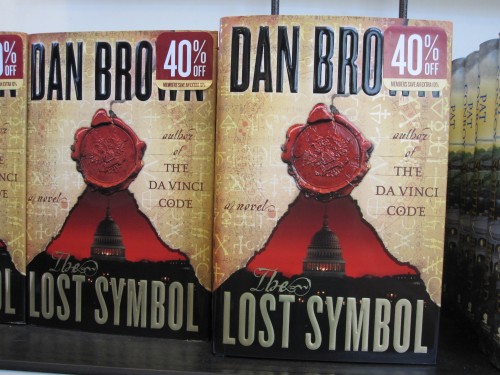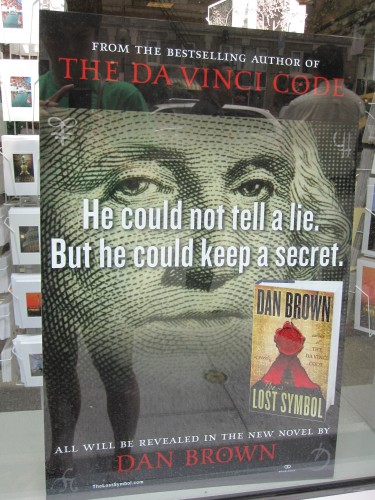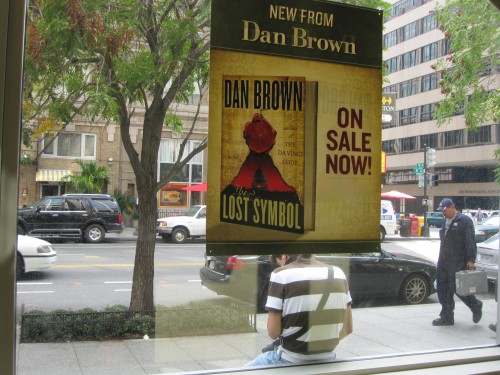
I see the future, I bend my thought to it: millions turning to these words and taking meaning from them, imbuing them with personal meaning; individuals comprehending “untold” mysteries written secretively in every building; a double decker bus with a speaker, the supreme leader shouting interpretations through the streets. That’s right, I see… The Lost Symbol Tour of DC. Now, this providential power of my mind to see this eventuality would be, in the world of Dan Brown’s The Lost Symbol, dramatic and surprising, never-before considered proof of the illimitable powers of the human mind. Use a heavy hand of the occult dressing and the secrecy sauce, and you can see the face of the Madonna in any piece of iceburg lettuce. This is Mr. Brown’s recipe–smash together enough philosophical minds, add a secret society, some underground passageways and a beastly sadomasochistic villain and you’ve got $1 million in first-day sales. Unfortunately the devices so intoxicating in The Da Vinci Code are ultimately working for a less sexy philosophical revelation in this latest installment. I raced along with the now-familiar “every-professor” Robert Langdon, pushing him on, only to arrive at the finish line going, “Wait. That’s it?!”
This is all sad to say, because I was really rooting for D Brown. I feel like it has to be hard being D Brown. This is a man who sat in watching undergrad creative writing examples and courses at Amherst with a man who has been heralded as one of the great literary minds of our generation, David Foster Wallace. He then went on first to a Barry-Manilow-esque, short-lived music career in LA, before writing 187 Men to Avoid under the pseudonym Danielle Brown. He wanted to be a writer, and he got his wish– but even as millions of educated individuals voraciously consumed his thrillers, they castigated his writing. He’s no Hemingway. That’s no Faulknerian prose. Then again, maybe I shouldn’t feel bad– The Da Vinci Code sparked an international fervor, making Brown a household name and assuredly making him something few writers become, a rich man. After myriad criticisms relating to not only Brown’s writing but his research–its factuality and originality–you could see why the man would take 6 years to write, and presumably carefully edit, the next installment.
However, writerly pity does not a good book make. In the early chapters of the book, I was sincerely (let DB google that for you!) engaged as the lineup of characters was revealed and the intrigue began. Matters of National Security! Secret societies and white-man Founding Father conspiracies! A 40-foot giant squid! When I had to look up a word (orthogonal), I even found myself thinking the writing was better than I remembered. Brown’s (or rather, Langdon’s) enthusiasm and reverence for the Nation’s Capitol was endearing at first. He practically has a romance explosion over the Reading Room in the Library of Congress. Long before the prescripted romantic tete-a-tete began and the Botanical Garden’s jungle room became a fearsome interrogation chamber (really?), however, I began to wonder where this was going.
The action in The Lost Symbol is precipitated by a tattooed, inhuman villain who has infiltrated the Masonic brotherhood in search of the keys to unlocking the Ancient Mysteries–knowledge that, if possessed by a man, will make him powerful beyond imagination. Beasty, known in the text variously by the names Mal’akh, Andros and Dr. Abbadon, tricks Langdon into coming to the Capital to give a lecture as a favor to Langdon’s mentor, the high-powered philanthropist (and Mason) Peter Solomon. Shockingly, there is no lecture, and Beasty is inviting Langdon, calmly and cooly, to participate in what alternately seems like a game and a quest of epic proportions: Langdon will (must!) help Beasty solve the puzzle of the Masonic Pyramid, which protects the Lost Word which holds the key to the Ancient Mysteries. In return, Beasty will preserve and release Peter Solomon. Langdon has all the pieces of the puzzle, including a gifted mind and eidetic memory, he only has to overcome his Doubt, elude the CIA special ops and drown to figure it out.
See, now, this sounds kind of titilating, doesn’t it? You’re looking up the book on Amazon right now. Masonic Pyramids, Lost Words, Ancient Mysteries. Click “yes” to being let in on all of the above. Trouble is that in this book, as in all DB novels, you are educated along with the characters, who always find up being dumber than you give them credit for. (Example: part of the secret is apparently hidden in a famous work by German high Renaissance artists Albrecht Durer, Melencolia I. They are looking for the “hidden” numbers 1514. Google that. No, wait, here. Do you see 1514? Of course you do. Now, it takes one of the most brilliant scientists in the book’s world, the one-dimensional Katherine Solomon, like 3 pages to see it. Later on, she also doesn’t recognize “Jeova Sanctus Unus” as being in Latin until Langdon points it out. Talk about suspension of disbelief.) Factoids deemed relevant are fed to you by slogging through the unrealistic dialogue between the characters, rather than a few quick expository paragraphs. Extra factoids are thrown in here and there as well, I presume because Brown has been reading (Wikipedia-ing?) about numerous obscure topics (i.e. blue manna crabs that migrate from the Bosphorus Strait) and needs to share them with someone. Some actions are extraneous as well; Langdon discovers a stone box flattens into a cross shape, which does nothing to help him solve the Masonic Pyramid, though it is useful to Brown as a unifying symbol.

The one thing that was really bugging me halfway through the book, was Beasty. What is his DEAL, anyway? Why is he doing all this evil business? I half-expected him to be some sort of Zionist whose family had been persecuted by the Masons, but two hundred pages in and I was still unclear about this dude’s motives. When the truth about Beasty is finally revealed, it is a Plot Twist, but one that could probably have been better exploited. Because Brown spends most of the book trying to conceal Mal’akh’s identity for the Big Moment, we don’t fully get to understand his mind as a character. But I guess maybe that is asking a lot.
Finally, after Beasty has been dispatched, we are let in on the SECRET OF THE LOST WORD. Oh sigh, if only it were as easy as that. Getting to, exposing, explaining, defending and philosophizing on the Lost Word–which, despite Peter Solomon’s assertions to the contrary, is not really, actually a word–takes a lot of time and energy. And maybe in the calm light of day (as compared to the dark night of 3 a.m. this morning) the ultimate revelation of the Ancient Mysteries would be poignant and important. But as the ending ties up happily, the stakes seem overblown. There is no explosive Virgin Mary scandal, just a pedestrian and familiar mystic humanism. If the human intellect is so vastly powerful, I couldn’t help asking myself as I put Langdon to bed, why couldn’t this book be more awesome?
http://www.flickr.com/photos/bom_mot/sets/72157622269892249/
This just solidifies my conviction not to read fiction newer than 50 years old.
Thanks, Acacia. You just saved me $20 or however much it costs. Does Harry Potter really dies in the end?
My biggest problem with the book was that Langdon did not even have to be involved. His buddy Peter new the answer all along and the location! Ma’lach could have done this without Langdon using his father alone. They really dumbed down Langdon in this book. How many times did the other characters have to point out the answers for him? Come on his is Robert Langdon, he should have figured things out on his own. It was a disappointment.
Pingback: We Love Weekends: Sept 26-27 » We Love DC
Pingback: Tourism: George Washington Masonic Memorial » We Love DC